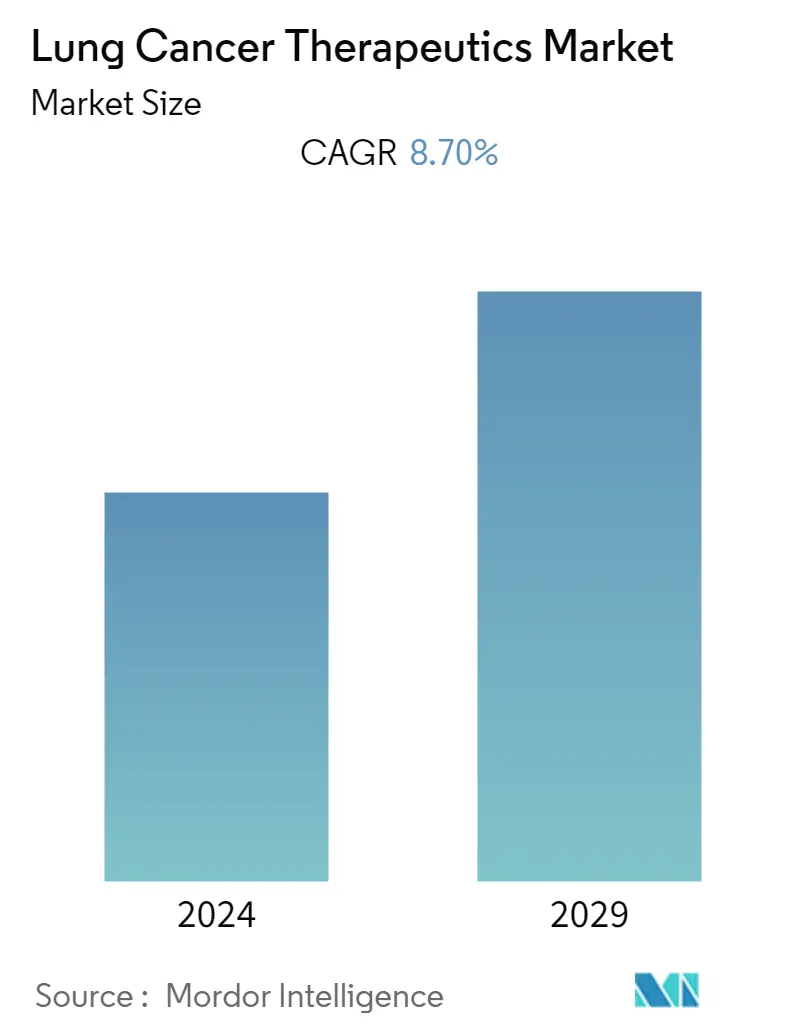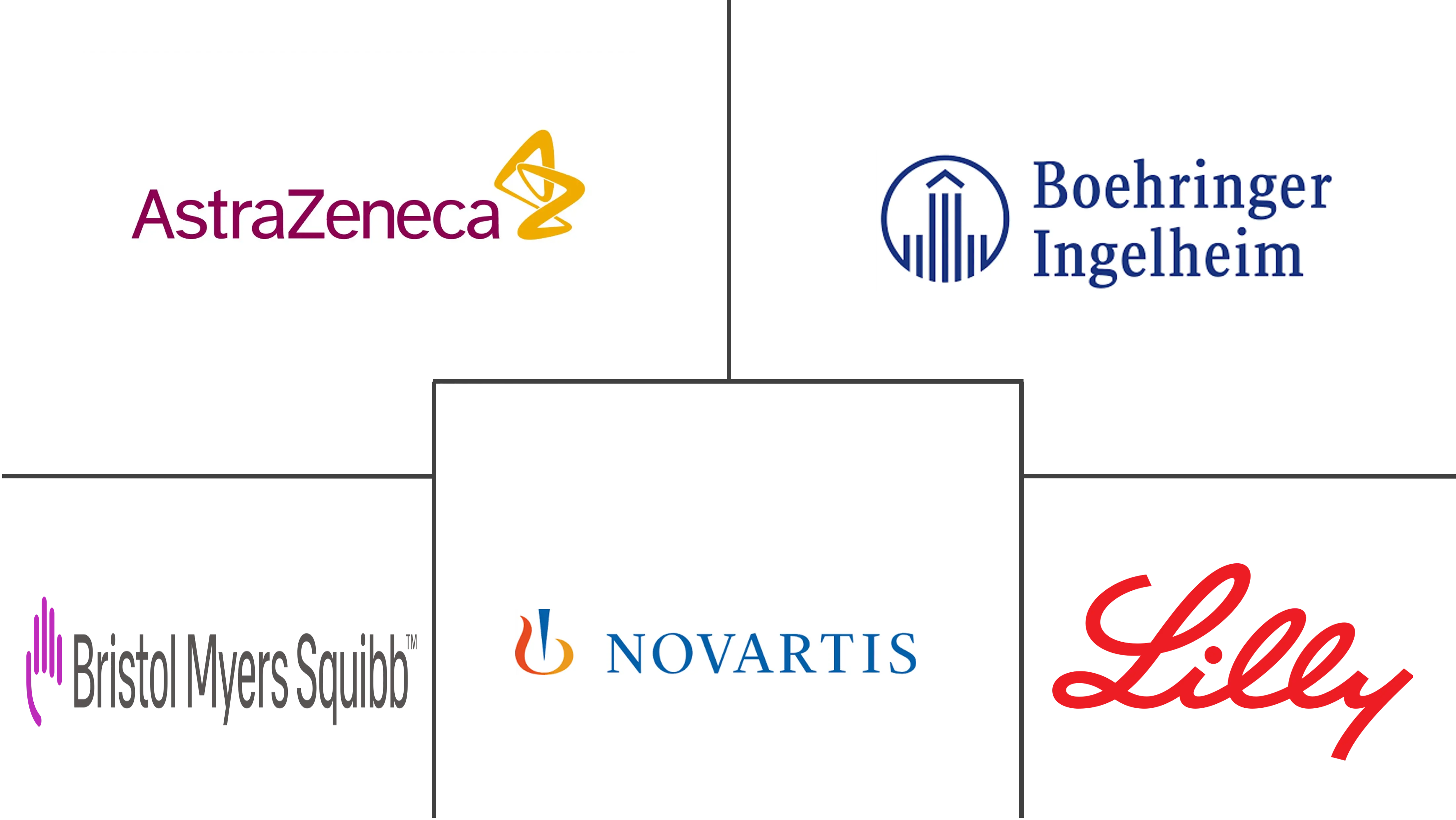Market Size of Lung Cancer Therapeutics Industry

| Study Period | 2019 - 2029 |
| Base Year For Estimation | 2023 |
| CAGR | 8.70 % |
| Fastest Growing Market | Asia Pacific |
| Largest Market | North America |
| Market Concentration | Medium |
Major Players
*Disclaimer: Major Players sorted in no particular order |
Lung Cancer Therapeutics Market Analysis
The lung cancer therapeutics market is projected to register a CAGR of 8.7% during the forecast period.
Patients with lung cancer were at a higher risk for SARS-CoV-2 infection as they typically receive immunosuppressive and chemotherapeutic drugs during treatment. Treating patients with lung cancer during the pandemic became a continuous challenge. To overcome the challenge, various organizations partnered to provide solutions and recommendations. For instance, according to an article published by the Journal for Immunotherapy of Cancer in January 2021, the European Society for Radiotherapy and Oncology and the American Society for Radiation Oncology partnered to provide treatment recommendations for stage I-III non-small cell lung cancer (NSCLC), prophylactic cranial irradiation for small cell lung cancer (SCLC), and palliative radiation for NSCLC. Furthermore, according to the above source, recommendations were given for an 'early pandemic scenario,' where the patient and radiotherapy staff risk mitigation was balanced with lung cancer treatment, and the 'later pandemic scenario,' where resources were limited, requiring patient triage. Hence, the initiatives taken by several organizations to overcome the treatment challenge increased the demand for lung cancer therapeutics. Additionally, there is better access to treatment than in the initial pandemic phase due to the lockdown; the market has reached its pre-pandemic level growth and is expected to grow significantly over the forecast period.
Factors driving the market growth include the increasing prevalence of lung cancer, rising pollution due to rapid industrialization, growth in the number of smokers, and increasing funding for the R&D of new drugs. For instance, as per the American Cancer Society's (ACS) data published in 2022, lung cancer (both small and non-small cell) is the second most common cancer in both men and women, making up almost 25% of all cancer deaths. Besides, according to the 2022 report by the American Lung Association, while the disease remains the leading cause of cancer deaths among women and men, the survival rate over the past five years has increased from 21% nationally to 25% yet remains significantly lower among communities of color at 20%. Hence, the increasing prevalence of cancer and the need for effective treatment is likely to contribute to market growth.
Furthermore, acquisitions, partnerships, mergers, and collaborations by the key players are also contributing to the market growth. For instance, in May 2021, Janssen Pharmaceutical reported that the U.S. FDA granted the accelerated approval of RYBREVANTTM (amivantamab-vmjw) for the treatment of adult patients with locally advanced or metastatic non-small cell lung cancer (NSCLC) with epidermal growth factor receptor (EGFR) exon 20 insertion mutations, as detected by an FDA-approved test, whose disease has progressed on or after platinum-based chemotherapy. Such product approvals are also adding to the growth of the market and are likely to do the same over the forecast period.
Hence, as per the factors above, the lung cancer therapeutics market is likely to grow over the forecast period. However, the side effects of drug therapies and the high cost of the treatments have been restraining the market growth.
Lung Cancer Therapeutics Industry Segmentation
As per the scope of the report, lung cancer or lung carcinoma is a disease characterized by uncontrolled cell growth in the lungs. Common symptoms include cough, chest pain, weight loss, and shortness of breath. Lung cancer therapeutic drugs and surgery are therapies aimed at diminishing, stunting, destroying, or killing the cancerous growth and cells in the lungs. The Lung Cancer Therapeutics Market is Segmented by Disease Type (Non-small Cell Lung Cancer and Small Cell Lung Cancer), Treatment (Chemotherapy, Radiation Therapy, Immunotherapy, Targeted Therapy, and Other Treatments), and Geography (North America, Europe, Asia-Pacific, Middle East and Africa, and South America). The Market report also covers the estimated market sizes and trends of 17 countries across major regions globally. The report offers the value (in USD million) for all the above segments.
| By Disease Type | |
| Non-small Cell Lung Cancer (NSCLC) | |
| Small Cell Lung Cancer (SCLC) |
| By Treatment | |
| Chemotherapy | |
| Radiation Therapy | |
| Immunotherapy | |
| Targeted Therapy | |
| Other Treatments |
| Geography | ||||||||
| ||||||||
| ||||||||
| ||||||||
| ||||||||
|
Lung Cancer Therapeutics Market Size Summary
The lung cancer therapeutics market is poised for significant growth, driven by an increasing prevalence of lung cancer, rising pollution levels, and a growing number of smokers. The market's expansion is further supported by substantial investments in research and development for new drugs. The COVID-19 pandemic posed challenges for lung cancer treatment due to the heightened risk of infection among patients receiving immunosuppressive and chemotherapeutic drugs. However, collaborative efforts by organizations such as the European Society for Radiotherapy and Oncology and the American Society for Radiation Oncology helped mitigate these challenges, thereby boosting the demand for lung cancer therapeutics. The market has since rebounded to pre-pandemic growth levels and is expected to continue its upward trajectory over the forecast period.
The North American lung cancer therapeutics market is anticipated to hold a significant share, attributed to the increasing incidence of lung cancer and a growing geriatric population. The region's market growth is also fueled by product approvals in the United States, such as the FDA's approval of LUMAKRAS for treating KRAS G12C-mutated non-small cell lung cancer. The competitive landscape of the market is moderately concentrated, with key players like AstraZeneca, Boehringer Ingelheim, and Bristol-Myers Squibb Company holding substantial market shares. These companies are actively involved in product developments and approvals, further propelling market growth. Despite challenges such as the high cost of treatments and side effects of drug therapies, the market is expected to witness robust growth, driven by ongoing innovations and strategic collaborations.
Lung Cancer Therapeutics Market Size - Table of Contents
-
1. MARKET DYNAMICS
-
1.1 Market Overview
-
1.2 Market Drivers
-
1.2.1 Increasing Prevalence of Lung Cancer
-
1.2.2 Rising Pollution due to Rapid Industrialization and Rise in the Number of Smokers
-
1.2.3 Increasing Funding in the Field of Research and Development of New Drugs
-
-
1.3 Market Restraints
-
1.3.1 Side Effects of Drugs
-
1.3.2 High Cost of Therapies
-
-
1.4 Porter's Five Force Analysis
-
1.4.1 Threat of New Entrants
-
1.4.2 Bargaining Power of Buyers/Consumers
-
1.4.3 Bargaining Power of Suppliers
-
1.4.4 Threat of Substitute Products
-
1.4.5 Intensity of Competitive Rivalry
-
-
-
2. MARKET SEGMENTATION (Market Size by Value - USD million)
-
2.1 By Disease Type
-
2.1.1 Non-small Cell Lung Cancer (NSCLC)
-
2.1.2 Small Cell Lung Cancer (SCLC)
-
-
2.2 By Treatment
-
2.2.1 Chemotherapy
-
2.2.2 Radiation Therapy
-
2.2.3 Immunotherapy
-
2.2.4 Targeted Therapy
-
2.2.5 Other Treatments
-
-
2.3 Geography
-
2.3.1 North America
-
2.3.1.1 United States
-
2.3.1.2 Canada
-
2.3.1.3 Mexico
-
-
2.3.2 Europe
-
2.3.2.1 Germany
-
2.3.2.2 United Kingdom
-
2.3.2.3 France
-
2.3.2.4 Italy
-
2.3.2.5 Spain
-
2.3.2.6 Rest of Europe
-
-
2.3.3 Asia-Pacific
-
2.3.3.1 China
-
2.3.3.2 Japan
-
2.3.3.3 India
-
2.3.3.4 Australia
-
2.3.3.5 South Korea
-
2.3.3.6 Rest of Asia-Pacific
-
-
2.3.4 Middle East and Africa
-
2.3.4.1 GCC
-
2.3.4.2 South Africa
-
2.3.4.3 Rest of Middle East and Africa
-
-
2.3.5 South America
-
2.3.5.1 Brazil
-
2.3.5.2 Argentina
-
2.3.5.3 Rest of South America
-
-
-
Lung Cancer Therapeutics Market Size FAQs
What is the current Global Lung Cancer Therapeutics Market size?
The Global Lung Cancer Therapeutics Market is projected to register a CAGR of 8.70% during the forecast period (2024-2029)
Who are the key players in Global Lung Cancer Therapeutics Market?
AstraZeneca, Boehringer Ingelheim, Bristol-Myers Squibb Company, Novartis AG and Eli Lilly and Company are the major companies operating in the Global Lung Cancer Therapeutics Market.

